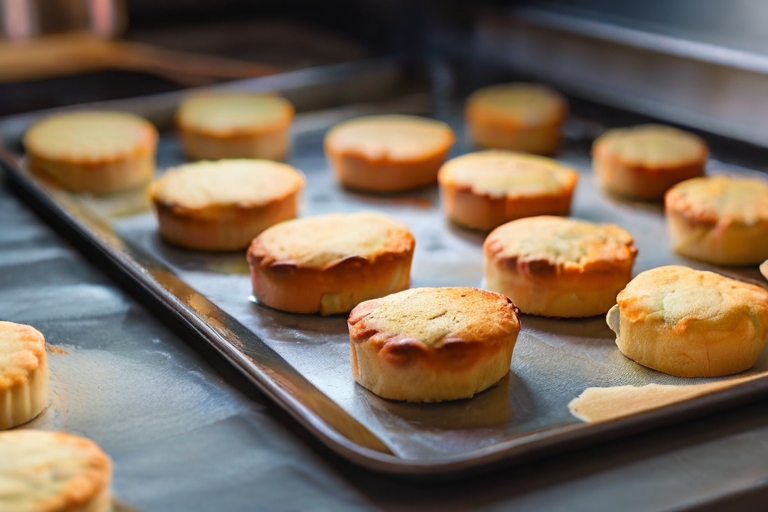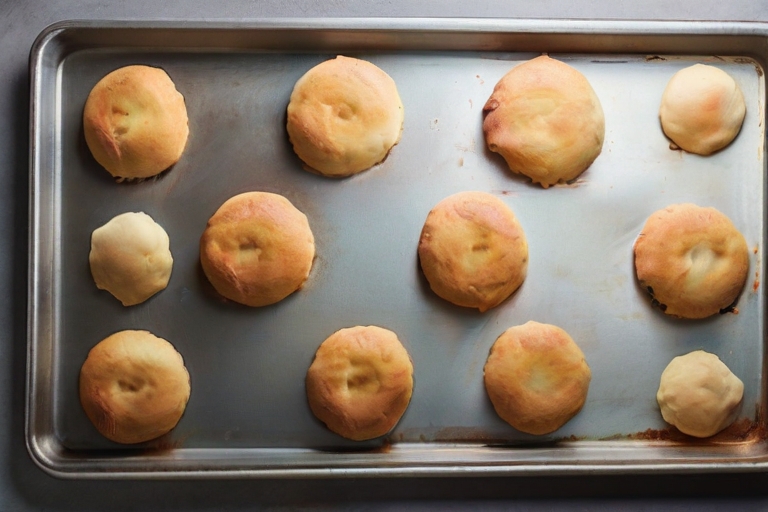Do you ever find yourself in the middle of a baking project and struggling to picture what a baking sheet looks like? Don't worry - we've all been there before!
In this blog post, we'll be taking an up-close look at the different types of baking sheets available, exploring their shapes and sizes, as well as shining some light on why using these surfaces for your cooking activities is so important.
Reading this post will help give you newfound confidence when it comes to adding professional touches to all your recipes. So grab your oven mitts and let's get started!
What Is A Baking Sheet?
A baking sheet, also known as a sheet pan or cookie sheet, is a flat, rectangular metal pan used for baking in the oven. It is typically made of aluminum, steel, or stainless steel and comes in various sizes, with the standard size being around 18x13 inches.
Baking sheets are versatile and can be used for a wide range of baking tasks, including baking cookies, pastries, bread, and other baked goods. They can also be used for roasting vegetables, toasting nuts, and even as a surface for assembling and decorating cakes and other desserts.
Baking sheets often have a raised edge, which helps to contain any juices or melted fats from food items being baked. They are designed to withstand high heat in the oven and are easy to clean, making them an essential tool for any home baker or cook.

Types Of Baking Sheets
There are several types of baking sheets available, each with their own unique features and benefits. The most common types include aluminum, stainless steel, non-stick, and insulated baking sheets. Aluminum baking sheets are lightweight, durable, and conduct heat evenly, making them perfect for a wide range of baking tasks
Stainless steel baking sheets are also popular for their durability and ability to resist rust and corrosion. Non-stick baking sheets are ideal for easily removing baked goods without the need for greasing or parchment paper. Insulated baking sheets feature a layer of air between two layers of metal, which helps to prevent burning and ensures even baking.
Each type of baking sheet has its own advantages and can be chosen based on personal preference and the specific baking needs. Ultimately, the type of baking sheet you choose will depend on the recipes you plan to make and your own baking habits.
Full Baking Sheet
A full baking sheet is a versatile and essential tool in any kitchen. It provides ample space to bake a variety of items, from cookies and pastries to roasted vegetables and sheet pan meals. The large surface area of a full baking sheet allows for even cooking and browning, ensuring that each item comes out perfectly baked.
Whether you’re preparing a sweet treat for a gathering or roasting vegetables for a weeknight dinner, a full baking sheet can handle it all. The durable construction of a baking sheet means it can withstand high temperatures and frequent use, making it a reliable kitchen staple.
Its flat surface also makes it easy to slide in and out of the oven, and its raised edges help prevent any spills or drips. With a full baking sheet on hand, you can elevate your baking and cooking game, easily preparing delicious and perfectly cooked dishes for you and your loved ones.
Large Baking Sheet
A full baking sheet is a versatile and essential tool for any home baker or chef. It provides ample space to bake a variety of delicious treats, from cookies and pastries to sheet cakes and roasted vegetables. The large surface area allows for even heat distribution, ensuring that your baked goods are cooked to perfection.
Whether you're hosting a holiday gathering or simply satisfying a sweet tooth, a full baking sheet has the capacity to make enough treats for a crowd. Additionally, it can also be used to roast vegetables or bake appetizers for entertaining.
The durable and easy-to-clean design of a full baking sheet makes it a practical and reliable kitchen essential. With its generous size and versatility, a full baking sheet is a fundamental tool for anyone who loves to bake and cook delicious homemade meals.
Medium Baking Sheet
The medium baking sheet is an essential tool for any home baker. Measuring about 13 x 18 inches, this versatile sheet is perfect for making a wide range of baked goods, from cookies and pastries to sheet cakes and roasted vegetables. Its size makes it ideal for small to medium-sized ovens, and its sturdy construction allows for even heat distribution and consistent results.
The rimmed edges prevent spills and make it easy to handle when taking it in and out of the oven. Whether you're a novice baker or a seasoned pro, the medium baking sheet is a must-have for your kitchen. It's also easy to clean and can be used for cooking savory dishes as well, making it a truly multifunctional tool. With the right care, a good quality medium baking sheet can last for years, making it a worthwhile investment for any home cook.
How To Choose A Baking Sheet
When choosing a baking sheet, there are a few key factors to consider. First, decide on the material. Aluminum baking sheets are a popular choice due to their ability to heat evenly and effectively, while stainless steel sheets are durable and resistant to rust and corrosion.
Next, consider the size. Half sheet pans are commonly used for a variety of recipes and fit well in most ovens, while full sheet pans offer a larger surface area for bigger baking projects. It's also important to think about the rim style of the baking sheet, with rimmed sheets being more versatile for containing juices and preventing spillage.
Finally, think about the coating. Non-stick coatings are convenient for easy clean-up, but some bakers prefer uncoated sheets for better browning and crispiness. Ultimately, choosing the right baking sheet comes down to personal preference and the specific needs of the recipes you plan to make.
What’s The Difference Between Sheet Pans, Cookie Sheets, And Baking Pans?
- Sheet pans, cookie sheets, and baking pans are all types of baking sheets.
- Sheet pans are the most common type of baking sheet and are typically made from aluminum or stainless steel. They have a shallow lip around the edges to prevent food from spilling over.
- Cookie sheets have a slightly deeper lip than sheet pans and are usually made from aluminum or non-stick materials.
- Baking pans are deeper than sheet pans and cookie sheets, and they come in a variety of shapes and sizes.
What Does A Baking Sheet Look Like?
- A baking sheet typically has a flat surface and shallow lip around the edges.
- The surface of the baking sheet can be smooth or textured, depending on the type of material it is made from.
- Sheet pans are usually made from aluminum or stainless steel, while cookie sheets and baking pans can be made from non-stick materials such as silicone or Teflon.
- Baking sheets come in a variety of sizes, from small to large.

How Can You Use A Baking Sheet?
Baking sheets are incredibly versatile and can be used for a variety of tasks in the kitchen. They're perfect for baking cookies, roasting vegetables, making granola bars, and even cooking pizza. You can also use them to bake bread, cakes, pies, and other desserts.
Are Baking Sheets Is Also Great For Reheating Leftovers Or Keeping Food Warm Before Serving?
No matter what type of baking sheet you choose, they all have one thing in common: they make cooking and baking easier! So next time you're in the kitchen, don't forget to reach for your trusty baking sheet.
When choosing a baking sheet, consider the type of food you’ll be preparing. For example, if you’re making cookies or other baked goods that require even heat distribution, opt for a metal sheet pan. If you’re roasting vegetables or baking something that requires a non-stick surface, choose a silicone mat or non-stick baking sheet.
Read Another Post: How to Make Rice in an Air Fryer? [The Ultimate Guide]
What Are The Benefits Of Using A Baking Sheet?
From perfectly roasted veggies to an even-baked cookie, using a baking sheet is key to kitchen success. It not only provides an evenly heated surface for food, but also keeps messes to a minimum as slides can easily be transferred from the countertop to the oven. With a baking sheet, clean up is simple; just rinse and go. No scrubbing pans required!
Baking sheets are also incredibly versatile--they can handle anything from roasting veggies to making your own pizzas--and come in all different shapes and sizes so you can find one that fits your needs. So if you're looking for low effort and high reward, get yourself a baking sheet; you won't regret it
How To Clean Baking Sheets So They Shine Like The Top Of The Chrysler?
Cleaning baking sheets can be a bit of a challenge, but it’s important to keep them clean and free from food residue. To get your baking sheets looking like new, start by scraping off any excess food with a spatula or spoon. Then, fill the sink with hot water and add a few drops of dish soap.
Soak the baking sheet for 10-15 minutes before scrubbing it with a non-abrasive sponge. Rinse the sheet with hot water and dry it with a clean cloth or paper towel. For stubborn stains, you can use a baking soda paste to help lift them off. Finally, buff the sheet with a microfiber cloth for an extra shine.
Frequently Asked Question (FAQs)
Q: What does a baking sheet look like?
A: A baking sheet, also known as a jelly roll pan or a rimmed baking sheet, is a flat metal pan with a raised edge to prevent food from sliding off.
Q: What is the difference between a jelly roll pan and a quarter sheet pan?
A: A jelly roll pan and a quarter sheet pan are essentially the same size, measuring around 9x13 inches, but the jelly roll pan has a rimmed edge while the quarter sheet pan may or may not have a rim.
Q: Are baking sheets and cookie sheets the same thing?
A: While people often use the terms interchangeably, there is a slight difference. Baking sheets have a rimmed edge, whereas cookie sheets are typically rimless.
Q: How do you use parchment paper on a baking sheet?
A: Simply line the baking sheet with parchment paper before placing the food on top. This prevents sticking and makes for easy cleanup.
Q: What is the best material for baking sheets?
A: Nonstick coated aluminum baking sheets are a popular choice due to their durability and even heat distribution. However, ceramic and insulated options are also available for different baking needs.
Q: Can a baking sheet be used in place of a roasting pan for a sheet pan dinner?
A: Yes, a rimmed baking sheet can be used as a roasting pan for sheet pan dinners, making it a versatile choice for cooking a complete meal in the oven.
Q: Do sheet pans come in different sizes?
A: Yes, sheet pans are available in various sizes, with half-sheet pans being a common choice for home kitchen use.
Q: What type of baking sheet is best for home ovens?
A: Nonstick baking sheets are ideal for use in home ovens, providing easy food release and quick cleanup.
Q: What is the purpose of a cooling rack in relation to a baking sheet?
A: A cooling rack can be placed on top of a baking sheet to allow air to circulate around the baked goods, promoting even cooling and preventing sogginess.
Q: Are sheet pans suitable for use in toaster ovens?
A: Yes, many sheet pans are compatible with toaster ovens, but it's important to check the size and compatibility of the specific pan with your toaster oven before use.
Conclusion
Baking sheets are a versatile and essential kitchen tool that can be used for a variety of tasks. They come in different sizes, shapes, and materials so you can find the perfect one to fit your needs. Knowing what baking sheets look like and how they’re used can help you get the most out of them in your cooking. Baking sheets are an easy way to get food quickly onto the table while still maintaining quality and flavor.

Meet Natalie P. Williams, the editor-in-chief of fryerly.com. With a background in journalism and a passion for healthy eating, Natalie has built the blog into a trusted source for air fryer cooking tips, tricks, and recipes.

